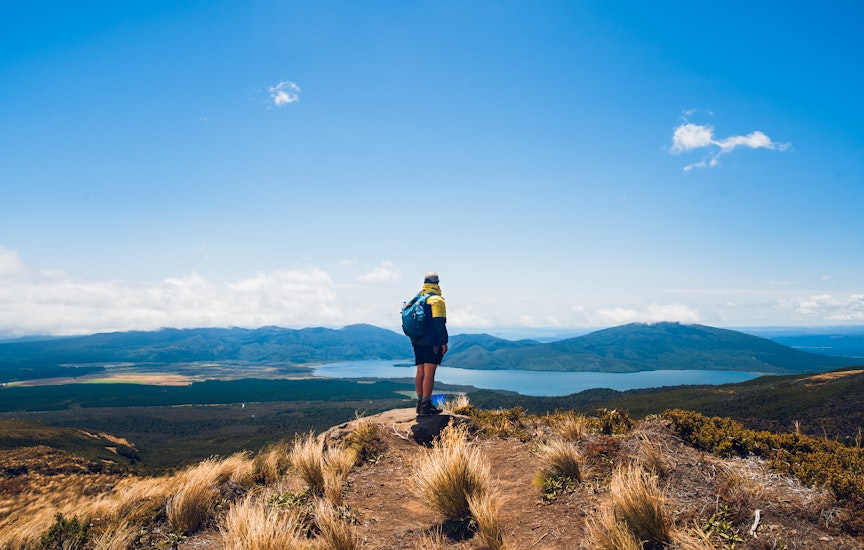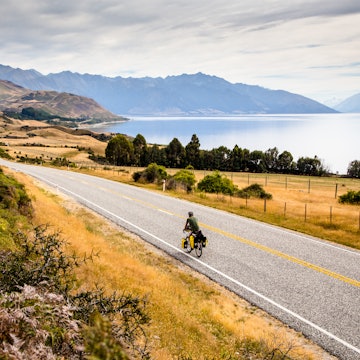
10 of the best things to do in Wellington, New Zealand's capital

Nov 11, 2025 • 7 min read

Views of Wellington from Mt Victoria. rui vale sousa/Shutterstock
Cutting-edge film making and world-leading movie studios give Wellington, a UNESCO City of Film, its "Wellywood" moniker. But with so many museums, galleries and cultural landmarks, New Zealand’s capital is also a place to explore arts and heritage. Adding to all that boundless creativity are harbor and city trails, nature-filled parks and outstanding craft beer, as well as an under-the-radar wine region that doubles as the city’s backyard. Looking for inspiration? Here's our pick of the best experiences in Wellington.

1. Explore the movies with industry insiders at Wētā Workshop
You can’t overlook the genius that’s been poured into the movie production house, museum and series of creative studios that make up Wētā Workshop. Its expert guides and on-site creatives – most of whom have worked on movies like the Lord of the Rings series, Avatar (2009) and District 9 (2009) – give its tours the ultimate credibility. Book the 90-minute tour to see the costumes, effects, make-up techniques and props of Academy Award-winning productions. There are designated areas to take photos and Wētā Cave, a souvenir shop crammed with all kinds of keepsakes, books and collectables. Don't miss the opportunity to take a top-rated behind-the-scenes tour of a real working studio.
Planning tip: It’s best to pre-book tickets, especially from October to April, when tours sell out. Wētā Workshop fills a nondescript corner site in suburban Miramar. Return transfers from central Wellington are available as part of your booking, or you can travel by public transport on Metlink’s route number 2, which drops passengers nearby.
2. Paddle a traditional Māori canoe in Wellington's waterfront
It’s all about experiencing manaakitanga (hospitality) and Māori cultural heritage at Te Wharewaka o Pōneke, a contemporary tribal venue and tour operator located on Wellington’s waterfront. Go inside to sign up for either a 1- or 2-hour guided waka (traditional Māori canoe) tour. Whichever you go for, you’ll experience a warm introduction to the people and culture of the Ati-Awa tribe. You’ll learn the commands and practices of traditional waka paddling and put them to the test on the water. Add to your ticket price a traditional Māori kai (meal) at Karaka Café next door where hāngī, a type of Indigenous earth oven cookery, is served.
Detour: Waka tours are weather dependent and sometimes need to be rescheduled. If you don’t have time to land a good weather day, Te Wharewaka o Pōneke's walking tours are an excellent alternative.

3. Be immersed in New Zealand's history at Te Papa
Museum of New Zealand Te Papa Tongarewa (commonly referred to as Te Papa) is that rarest of things: a national institution that’s anything but conventional, and where the storytelling is genuinely fresh. Dominating a significant site on Wellington’s waterfront, its exhibitions are a mix of enlightening learning spaces, big-hitting international installations and immersive displays. Head to Gallipoli: The Scale of Our War on level 2 for of a truly original exhibition depicting war created by NZ film director Sir Peter Jackson and Wētā Workshop. Larger-than-life human sculptures draw you into the narrative of eight New Zealanders who served in the Gallipoli campaign of WWI. There is no way to leave this exhibition unmoved.
Planning tip: A Gallipoli 9:30am entry ticket gives you access to the exhibition before the crowds arrive at 10am. Booking online is recommended.
4. Learn about the suffragette movement at the Parliament Buildings
Shaped just as its nickname will have you believe, the “Beehive” is the executive wing of New Zealand’s Parliament Buildings located in the city’s government precinct of Thorndon. It is here – on a free walking tour – you can learn about the suffragette movement in New Zealand and how Aotearoa (NZ’s Māori language name) became the first country in the world where women won the right to vote in 1893. The 1-hour tour, called Kicking Down the Doors: Women in Parliament, imparts fascinating facts – such as New Zealand elected the world’s first transgender MP, Georgina Beyer, in 1999 – as you walk parliament’s halls. Go online to check tour dates and book your spot. Other walking tours of interest include the Kids in the House Tour aimed at children aged 5 to 12, the Arts and Objects Tour led by parliament’s collections curator and a Māori history tour.
Detour: On display across the road at the National Library of New Zealand is the original 1893 women’s suffrage petition. View it on a self-guided stroll or take the library’s 1-hour guided tour for more on New Zealand’s suffrage movement.

5. Jump and splash into Wellington harbor
Launch into the air, arms out and form a V-shape as you plunge into the harbor. This one’s for anyone who loves to make a splash, while getting in on a favorite New Zealand pastime. “Popping a manu” (manu being the te reo Māori word for bird) is a trend in public diving, originating in New Zealand’s Māori and Pasifika communities and popular on Wellington harbor, especially in summer (though a sunny day at any time of year will suffice). The point is to use your body to make the biggest possible splash. While Auckland is where the finals of the Manu World Champs are held every year, Wellington’s waterfront area and purpose-built diving platforms make for excellent jumping off points.
Local tip: For inspiration and to study technique, head to the nearly 8m Taranaki Wharf Jump Platform next to Te Papa on a warm day and watch locals pop a manu – then put on your togs (that’s Kiwi for swimsuit) and give it a go yourself. It’s fun. And it’s free.
6. Head up to Mt Victoria Lookout for a city panorama
The capital’s best viewing point is Mt Victoria Lookout. At 196m high, it is easily accessible from the city center by car, bike and on foot. The bus (number 20, departing from Courtenay Place) also takes you there. Expect views of downtown and the harbor in one direction and the suburbs that fan out to the airport and the south coast in the other. Go for the panoramic scene, to hike or cycle Mt Victoria’s many trails and to explore popular Wellywood film locations like the Hobbit Hideaway filmed on the slopes of Mt Victoria and seen in The Fellowship of the Ring (2001). Look for signposts clearly marking how to navigate your way around this popular recreational area.

7. Shop for retro treasures on Cuba St
On Cuba St, fashion’s trend setters are sustainable shopping outlets like Paperbag Princess, Hunters and Collectors and Spacesuit. The walkable street is a jumble of retro boutiques, independent record stores, secondhand bookshops and craft beer favorites like Heyday, a dog-friendly brewpub on Upper Cuba St with a spacious outdoor courtyard. History is everywhere: the street name itself references a settler ship called Cuba that arrived in Wellington in 1840. Many of the street’s buildings are heritage-listed. Cuba Mall’s Bucket Fountain, designed in 1969 for the mall’s opening, more recently doubled as a portal to hell on mockumentary, Wellington Paranormal, screening on Apple TV.
8. Take a brewery tour
Wellington is a craft beer haven, and a brewery tour of Garage Project’s Wild Workshop Taproom and Cellar Door on Furness Lane drops you directly into the scene. Its 1-hour, six beer tour is worth doing not only because it's the first brewery tour ever offered by Garage Project, but also because you’ll see firsthand how these talented brewers push the creative limits. Tours are held at limited times only on Fridays, Saturdays and Sundays.
Detour: Prefer a more extensive self-guided tour? Craft Beer Capital has a downloadable map of the city’s microbreweries – many of which are in easy walking distance from the city center.

9. Look for little spotted kiwi on a sanctuary night tour
On the Zealandia by Night tour it is possible to come across little spotted kiwi foraging quietly among the leaf litter. If you do, count yourself lucky. These small flightless birds, known as pukupuku in te reo Māori, are the rarest of New Zealand’s five national species. A hundred-or-so of the precious nocturnal birds live in Wellington’s urban wildlife sanctuary, Zealandia Te Mārā a Tāne, protected by a predator-proof fence. Other birds to see independently or on a guided day tour of the sanctuary include tūī, kererū and kākā. But go at night for glowworms, tuatara (a small endemic reptile) and little spotted kiwi.
Planning tip: Get there using the free, daily city-to-sanctuary e-shuttle, departing near the Michael Fowler Centre on Wakefield St and top of the Wellington Cable Car. At night, you’ll need to drive or take a taxi.
10. Try wine in Wairarapa's under-the-radar tasting rooms
Polish off your stay in Wellington with a short break in Martinborough, the capital’s favorite wine village in Wairarapa. Go for the day or stay the weekend to sip world-class pinot noir and other cooler-climate wines from this largely undiscovered wine region. Travel there by train (a connecting bus service will take you from Featherston to Martinborough village) or self-drive over the Remutaka Ranges into the rural township. Vineyard walking tours and hiring a bike to cycle between tasting rooms are popular ways to explore – as are winery lunches and Wairarapa’s seasonal festivals.
Planning tip: Bookings are recommended for village accommodation and all tours, such as Martinborough Wine Tours, especially in summer.














